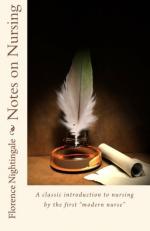Generally speaking, you may expect that weak patients will suffer cold much more in the morning than in the evening. The vital powers are much lower. If they are feverish at night, with burning hands and feet, they are almost sure to be chilly and shivering in the morning. But nurses are very fond of heating the foot-warmer at night, and of neglecting it in the morning, when they are busy. I should reverse the matter.
All these things require common sense and care. Yet perhaps in no one single thing is so little common sense shewn, in all ranks, as in nursing.[5]
[Sidenote: Cold air not ventilation, nor fresh air a method of chill.]
The extraordinary confusion between cold and ventilation, in the minds of even well educated people, illustrates this. To make a room cold is by no means necessarily to ventilate it. Nor is it at all necessary, in order to ventilate a room, to chill it. Yet, if a nurse finds a room close, she will let out the fire, thereby making it closer, or she will open the door into a cold room, without a fire, or an open window in it, by way of improving the ventilation. The safest atmosphere of all for a patient is a good fire and an open window, excepting in extremes of temperature. (Yet no nurse can ever be made to understand this.) To ventilate a small room without draughts of course requires more care than to ventilate a large one.
[Sidenote: Night air.]
Another extraordinary fallacy is the dread of night air. What air can we breathe at night but night air? The choice is between pure night air from without and foul night air from within. Most people prefer the latter. An unaccountable choice. What will they say if it is proved to be true that fully one-half of all the disease we suffer from is occasioned by people sleeping with their windows shut? An open window most nights in the year can never hurt any one. This is not to say that light is not necessary for recovery. In great cities, night air is often the best and purest air to be had in the twenty-four hours. I could better understand in towns shutting the windows during the day than during the night, for the sake of the sick. The absence of smoke, the quiet, all tend to making night the best time for airing the patients. One of our highest medical authorities on Consumption and Climate has told me that the air in London is never so good as after ten o’clock at night.




